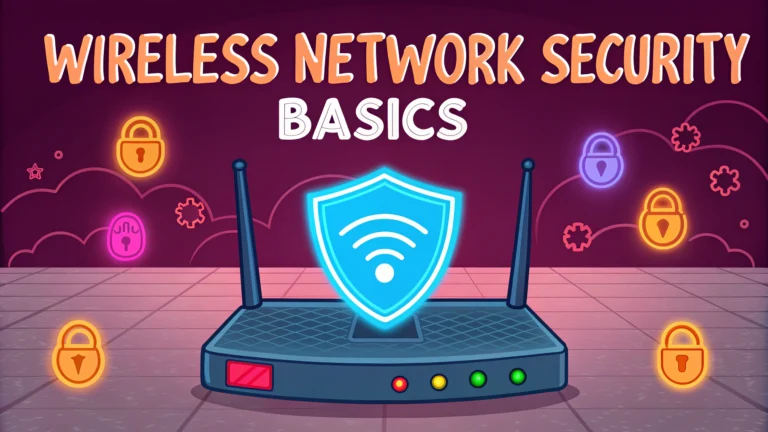Wireless networks remain one of the most common entry points for attackers due to their inherent vulnerabilities and widespread deployment.
This guide covers essential wireless network security testing techniques used by ethical hackers and penetration testers.
Initial Wireless Network Assessment
- Identify wireless networks in range using tools like Kismet or airodump-ng
- Determine encryption types (WEP, WPA, WPA2, WPA3)
- Map network coverage and identify rogue access points
- Capture handshakes for offline password cracking
Common Attack Vectors
Each wireless security protocol has specific vulnerabilities that can be tested:
| Protocol | Attack Methods |
|---|---|
| WEP | IV attacks, ARP replay, chopchop attack |
| WPA/WPA2 | Dictionary attacks, PMKID attacks, evil twin |
| WPA3 | Downgrade attacks, side-channel attacks |
Testing Tools
- Aircrack-ng Suite: Packet capture, injection, and cracking
- Wireshark: Network traffic analysis
- Wifite: Automated wireless auditing
- Hashcat: Password recovery
Security Testing Steps
- Put wireless interface into monitor mode
- Scan for available networks
- Capture authentication handshakes
- Test for WPS vulnerabilities
- Attempt password recovery using dictionaries
- Check for client-side vulnerabilities
Mitigation Strategies
- Use WPA3 where possible
- Implement strong passwords (minimum 12 characters)
- Enable MAC filtering
- Regularly update firmware
- Disable WPS
- Use enterprise authentication for business networks
Contact your wireless equipment manufacturer for specific security recommendations and firmware updates.
Legal Considerations
Always obtain written permission before testing any wireless networks you don’t own.
For professional wireless security assessments, contact organizations like SANS (www.sans.org) or (ISC)² (www.isc2.org).
Additional Resources
Advanced Testing Techniques
Packet Injection Testing
- Test network response to deauthentication attacks
- Validate client isolation effectiveness
- Assess network behavior under load
- Check for rate limiting implementations
Enterprise Network Assessment
- Evaluate RADIUS server configuration
- Test EAP implementation security
- Verify certificate validation processes
- Check for proper VLAN segmentation
Reporting and Documentation
- Document all discovered vulnerabilities
- Capture relevant packet traces as evidence
- Include risk ratings for each finding
- Provide detailed remediation steps
- Create executive summary for stakeholders
Conclusion
Wireless network security testing requires a methodical approach combining technical expertise with appropriate tools and techniques. Regular assessment helps identify vulnerabilities before malicious actors can exploit them.
Key takeaways:
- Always maintain proper documentation and authorization
- Stay updated with latest wireless security standards
- Implement defense-in-depth strategies
- Regularly update testing methodologies
- Follow responsible disclosure procedures
Remember that wireless security is an ongoing process requiring continuous monitoring and updates to maintain effective protection against evolving threats.
FAQs
- What are the most common wireless network vulnerabilities?
WEP/WPA vulnerabilities, rogue access points, weak passwords, misconfigured access points, lack of encryption, man-in-the-middle attacks, and deauthentication attacks. - Which tools are essential for wireless penetration testing?
Aircrack-ng suite, Wireshark, Kismet, Wifite, Reaver, WiFi Pineapple, and a wireless adapter capable of packet injection and monitor mode. - How can I detect rogue access points in a network?
Using tools like Kismet or Airodump-ng to scan for unauthorized APs, comparing MAC addresses with authorized list, monitoring signal strengths, and analyzing beacon frames. - What is the difference between WEP, WPA, and WPA2 cracking?
WEP uses weak RC4 encryption and can be cracked within minutes, WPA uses TKIP and can be vulnerable to dictionary attacks, WPA2 uses stronger AES encryption but can be compromised through WPS vulnerabilities or handshake captures. - How does a WPA handshake capture work?
It involves capturing the four-way authentication handshake between client and access point, which can then be used with tools like aircrack-ng to perform offline dictionary or brute-force attacks. - What is Evil Twin attack and how does it work?
An Evil Twin attack creates a duplicate of a legitimate access point with the same SSID, causing users to connect to the malicious AP instead, allowing the attacker to intercept traffic. - How can wireless networks defend against deauthentication attacks?
Implementing 802.11w Protected Management Frames (PMF), using WPA3, monitoring for unusual deauthentication frames, and maintaining updated firmware on network devices. - What are the key components of a wireless penetration testing report?
Executive summary, methodology, tools used, vulnerabilities discovered, risk assessment, impact analysis, detailed technical findings, and recommended remediation steps. - Why is MAC address filtering not a reliable security measure?
MAC addresses can be easily spoofed using tools like macchanger, making it simple for attackers to bypass this security control by cloning authorized device addresses. - What is WPS and why is it vulnerable?
WiFi Protected Setup (WPS) is a simplified connection method that can be compromised through brute-force attacks on its PIN, particularly with tools like Reaver, due to design flaws in the protocol.







